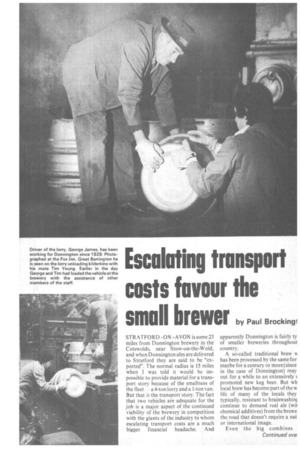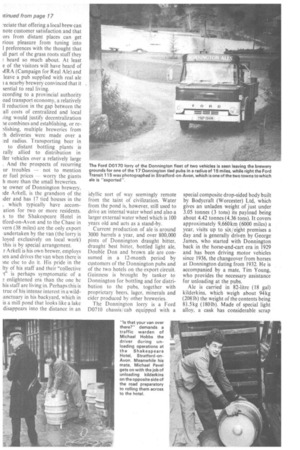Escalating transport costs favour the
Page 19

Page 20

Page 21

If you've noticed an error in this article please click here to report it so we can fix it.
smallbrewer by Paul Broclungl
STRATFOR D QN -AVON is some 23 miles from Donnington brewery in the Cotswolds, near Stow-on-the-Wold, and when Donnington ales are delivered to Stratford they are said to he "exported". The normal radius is 15 miles when I was told it would be impossible to provide material for a transport story because of the smallness of
the fleet a 4-ton lorry and a 1-ton van. But that is the transport story. The fact that two vehicles are adequate for the job is a major aspect of the continued viability of the brewery in competition with the giants of the industry to whom escalating transport costs are a much bigger financial headache. And
apparently Donnington is fairly ty of smaller breweries throughout country.
A so-called traditional brew v, has been processed by the same for. maybe for a century or more (since in the case of Donnington) may out for a while to an extensively promoted new keg beer. But wh local brew has become part of the w life of many of the locals they typically, resistant to brainwashini continue to demand real ale (wit chemical additives) from the brewe the road that doesn't require a nat or international image.
Even the big combines Continued ove
-eciate that offering a local brew can note customer satisfaction and that ors from distant places can get rious pleasure from tuning into preferences with the thought that ill part of the grass roots stuff they heard so much about. At least e of the visitors will have heard of v1RA (Campaign for Real Ale) and leave a pub supplied with real ale a nearby brewery convinced that it sential to real living.
ccording to a provincial authority oad transport economy, a relatively II reduction in the gap between the all costs of centralized and local iing would justify decentralization le combines and establishing, or refishing, multiple breweries from :h deliveries were made over a :ed radius. Transporting beer in to distant bottling plants is rally allied to distribution in Iler vehicles over a relatively large . And the prospects of recurring ur troubles — not to mention er fuel prices worry the giants h more than the small breweries. le owner of Donnington brewery, ide Arkell, is the grandson of the [der and has 17 tied houses in the , which typically have aecomation for two or more residents. s to the Shakespeare Hotel in tford-on-Avon and to the Chase in vern (38 miles) are the only export undertaken by the van (the lorry is loyed exclusively on local work) this is by special arrangement.
r Arkell is his own brewer, employs ten and drives the van when there is me else to do it. His pride in the lty of his staff and their "collective -t" is perhaps symptomatic of a enlightened era than the one he his staff are living in. Perhaps this is true of his intense interest in a wildanctuary in his backyard, which in is a mill pond that looks like a lake disappears into the distance in an idyllic sort of way seemingly remote from the taint of civilization. Water from the pond is, however, still used to drive an internal water wheel and also a larger external water wheel which is 100 years old and acts as a stand-by.
Current production of ale is around 3000 barrels a year, and over 800,000 pints of Donnington draught bitter, draught best bitter, bottled light ale, Double Don and brown ale are consumed in a 12-month period by customers of the Donnington pubs and of the two hotels on the export circuit. Guinness is brought by tanker to Donnington for bottling and for distribution to the pubs, together with proprietary beers. lager, minerals and cider produced by other breweries.
The Donnington lorry is a Ford D0710 chassislcab equipped with a special composite drop-sided body built by Bodycraft (Worcester) Ltd, which gives an unladen weight of just under 3.05 tonnes (3 tons) its payload being about 4.42 tonnes (4.36 tons). It covers approximately 9,660km (6000 miles) a year, visits up to six/eight premises a day and is generally driven by George James, who started with Donnington back in the horse-and-cart era in 1929 and has been driving motor vehicles since 1936, the changeover from horses at Donnington dating from 1932. He is accompanied by a mate, Tim Young, who provides the necessary assistance for unloading at the pubs.
Ale is carried in 82-litre (18 gal) kilderkins, which weigh about 94kg (208 lb) the weight of the contents being 8.I.5 kg (1801b). Made of special light alloy, a cask has considerable scrap value, and big breweries have complained of heavy financial loss through pilferage. This is no problem on the Donnington circuits.
A full load of kilderkins and crates of bottled ale can be put on the lorry in a few minutes at the brewery with the aid• of extra helpers, although unloading at the pubs and transferring the load takes considerably longer. It would be a backbreaking business if it were not for an expertise in making light of weighty burdens, and judging by George James it's a healthy sort of lifetime job. Employing kilderkins in place of brewers' barrels of 164 litres (36 gal) is a valuable time-and-labour-saving facility.
• The van is a Ford Transit dieselengined 115 which is equipped with a thick rubber floor covering to provide safe load handling, and its low running costs enable deliveries to be made on export runs carrying 1-ton loads of draught best bitter without straining the economy. At the time of writing this ale sells in Stratford at 23p/ pint and at 18p / pint in Donnington pubs, while ordinary draught is 16p/pint in the brewery area. So it's competitive; even real ale has to be in these uncertain times.
Mr Arkell charges his tenants a low rent, and combined with his readiness to meet the building costs of improvements this encourages them to play their part in exploiting the potential of their premises to the full. The transport of lighter building materials is fairly routine for the Donnington lorry and van.
Food is available at all the Donning ton pubs, which is cited by Mr Arkell a means of backing a leisure industr3 with an essential service. But while gam solid food is of the essence in winning through at any time customers havt claimed that real ale is of greater valtu as a liquid food for getting by in nationa crises and for shrugging off the prophet; of doom at yuletide.
Although breweries with a pro duction capacity of more than, say 350,000 barrels a year are said to have ; big advantage over smaller breweries ii terms of optimizing the utilization o modern plant to the full and of red ucin, labour content to the minimum, M Arkell points out that the availability a up-to-date equipment for brewing on small scale, together with the expertis, of specialists, is a facility which ha helped to keep the small brewer going But he emphasizes that the low mileag of his vehicles relative to the loads deli vered is a key factor in continued profit ability because it largely compensate the considerably higher cost of raN materials purchased in smalle quantities. On average the vehicles carr an 80 per cent load on outward journe3 and they normally return with a load ( empties. Easy access to the backyards ( premises is a boon which cuts journe times and thus helps to reduce overa transport costs.
In the absence of detailed runnir costs of the lorry and van, the operatir conditions speak for themselves. Traff congestion within a 15-mile radius of ti brewery virtually unknown, ti vehicles are maintained to a hig standard at a Stow-on-the-Wo garage, there are no industrial disput or (as mentioned) pilferage, and ti gaffer himself is always there to sett any arguments in a personal way. B smallness does not mean isolation in crisis, according to Mr Arkell. "0th breweries, large or small, will alwa help out in an emergency," he says.
Pelleted hops
A supply of hops sufficient for a yeat production is delivered to the brewery a single transport exercise; ben pelleted and vacuum-sealed the hoi occupy about 20 per cent of the norm space and retain their quality. Some years ago the grain for malted banl was grown nearby on Mr A rkell's fan but it is now supplied by a merchant Cirencester.
Modestly, Mr Arkell • considers th his brewery is rather too small to go the maximum benefit from small-sci production and limited-radius dist bution. He regards the 100-pub brewe as the best size, with perhaps five or members of the family as directo Donnington is one of about 30 sm breweries in England and Scotia which have advertized nationally a: group of wholly independent fam concerns.




































































